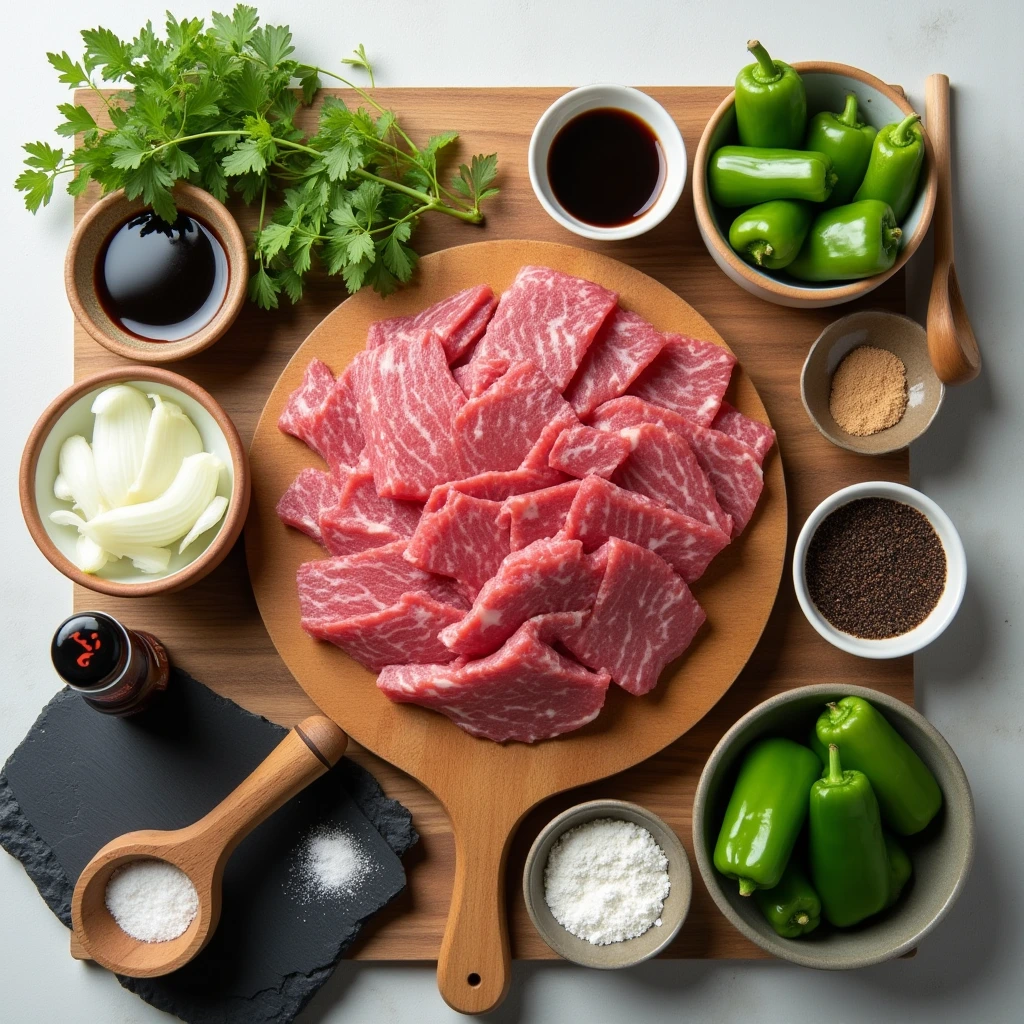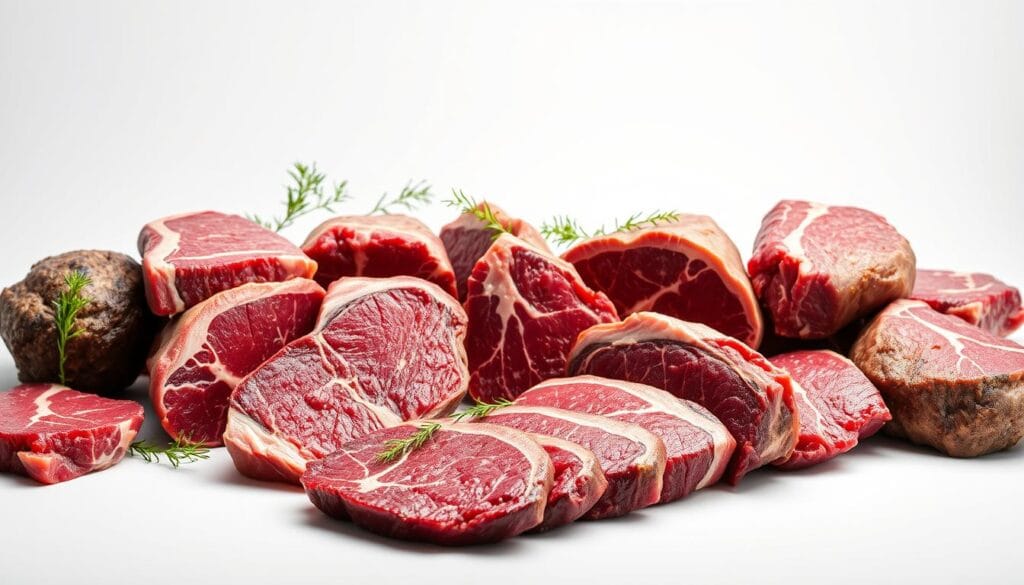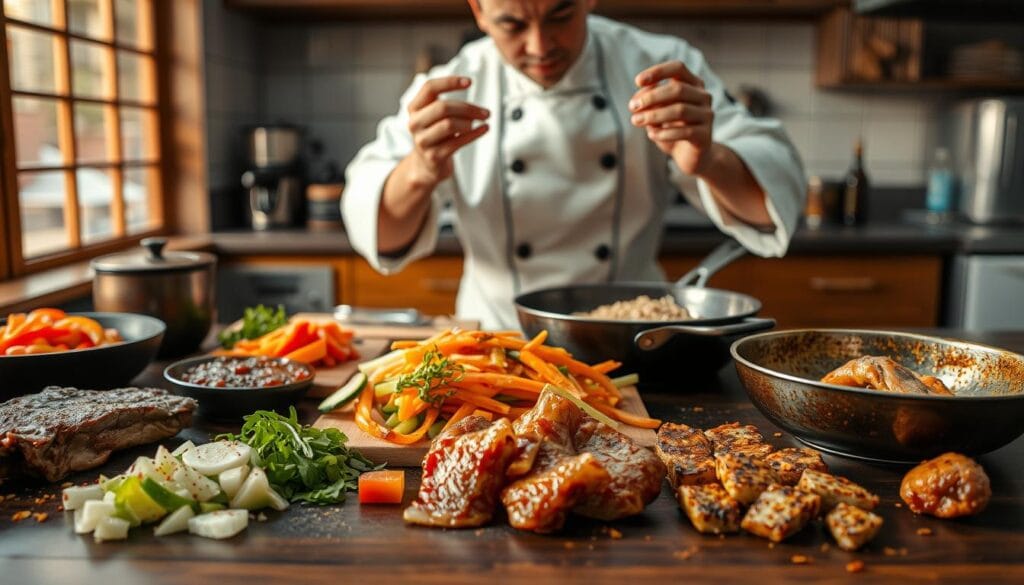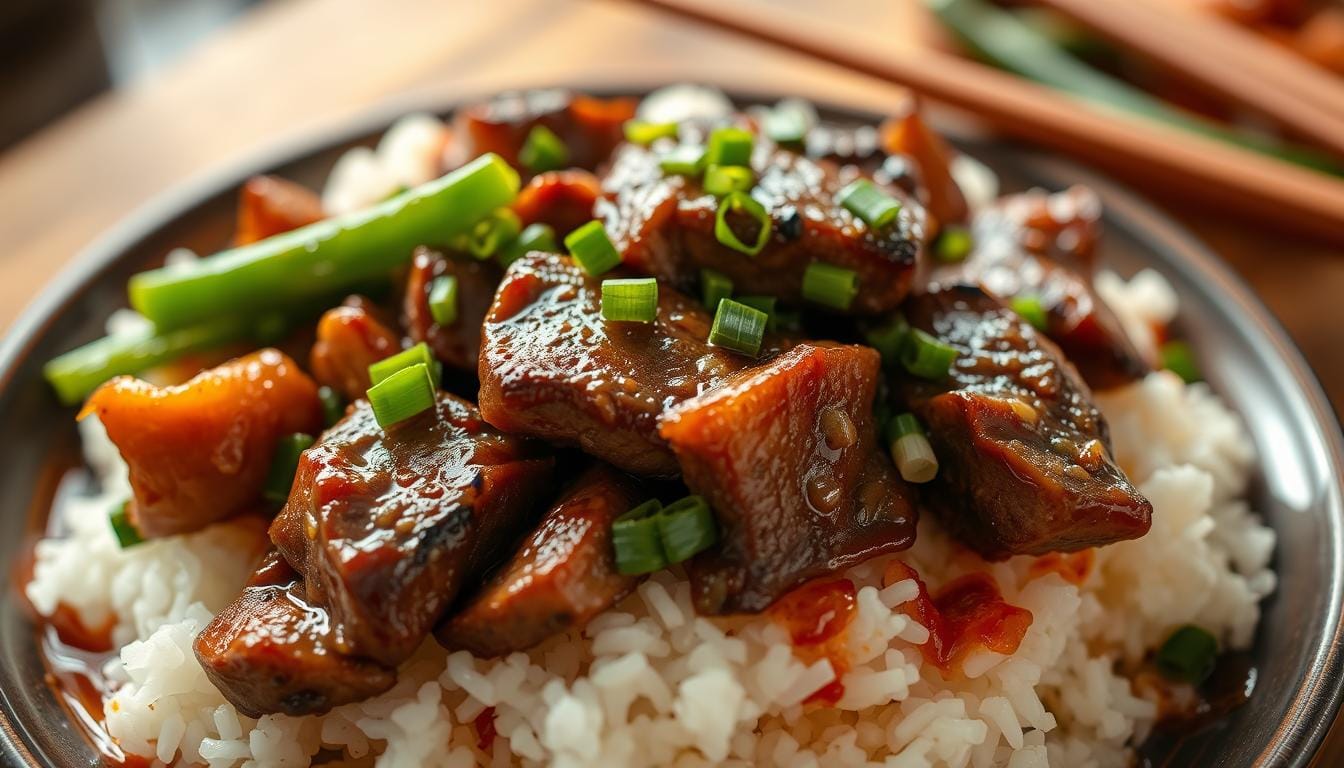Table of Contents
Imagine a weeknight dinner where your family comes together. They’re all excited for japanese pepper steak. The dish is full of crisp peppers, tender beef, and flavorful rice. It’s a mix of deep flavors and quick cooking.
What if making it at home was as simple as using a skillet and soy sauce? It’s like having a taste of Tokyo without leaving your house.
This dish is more than just a meal. It’s a celebration of bold flavors. You’ll learn how to make a sauce with sweet, salty, and smoky notes. And you’ll find out why the right beef is key.
By the end, you’ll know how to make a homemade japanese pepper steak that’s as good as a restaurant’s. But it’s easy enough for busy nights.
Key Takeaways
- Master a 30-minute recipe that combines beef, peppers, and a signature savory-sweet sauce.
- Discover how to select and prepare beef for maximum tenderness and flavor absorption.
- Learn to adjust spice levels to match your family’s preferences without losing authenticity.
- Get tips for plating that elevates the dish from weeknight dinner to dinner-party showstopper.
- Find budget-friendly ingredient swaps that keep the recipe accessible without sacrificing taste.
What Makes Japanese Pepper Steak a Popular Asian Dish
Japanese pepper steak has become a favorite worldwide because of its deep roots. It combines history and flavor, making it loved far beyond Japan.
Origins of Traditional Japanese Pepper Steak
This dish started in Japan in the early 1900s. It’s known for its tangy-sweet sauce, made from soy sauce, sugar, and red pepper flakes. This unique flavor became a hit in homes and restaurants.
Comparing Cultures: Japanese vs. Other Pepper Steaks
Japanese pepper steak is different from Chinese hu beef with its bold spices and thick sauces. Western pepper steaks often use black pepper and cream-based gravies. But Japanese versions use mirin and sake for a bright taste. The key is the karashi (Japanese mustard) and bell peppers.
Why It’s a Global Hit
Its simple yet bold flavors have made it popular worldwide. Chefs in places like New York and Los Angeles serve it with rice or noodles. Social media and food shows have also helped it become a favorite for those trying Asian dishes.
Essential Ingredients for Authentic Japanese Pepper Steak
To make authentic Japanese pepper steak, you need the right ingredients. Each part adds to the dish’s unique taste. Here’s what you’ll need:
- Beef: Thinly sliced sirloin or ribeye are best. Choose tender cuts with little gristle for a soft texture.
- Vegetables: Green bell peppers and onions are must-haves. Don’t overcook them to keep them crisp, a key feature of japanese pepper steak.
- Seasonings: Soy sauce brings out the umami. Mirin (sweet rice wine) and sake balance the flavors. Black pepper and oyster sauce add depth.
- Extras: Cornstarch thickens the sauce, and sesame oil adds aroma. Use Kikkoman soy sauce or Marukan mirin for true taste.

For alternatives, use sugar and rice vinegar instead of mirin. Omit oyster sauce if you don’t eat seafood, but it’s crucial in authentic japanese pepper steak. You can find these ingredients at Mitsuwa or online via Amazon Japan. Always check labels for gluten-free options if needed.
Selecting the Perfect Cut of Beef for Your Japanese Pepper Steak
Choosing the right beef is key to a tender and flavorful homemade Japanese pepper steak. This guide will help you pick cuts that are both tasty and budget-friendly. You’ll also learn how to prepare them perfectly.
Best Steak Cuts for Tender Results
- Ribeye: Rich marbling keeps it juicy. Best for those prioritizing flavor.
- Sirloin: Lean but tender when sliced thinly. Ideal for a balance of cost and texture.
- Strip Steak: Firm with a buttery finish. Slices evenly for consistent cooking.
Budget-Friendly Alternatives That Work Well
| Cut | Cost | Prep Tips |
|---|---|---|
| Flank Steak | Low | Marry with soy sauce or acid before cooking. |
| Chuck | Moderate | Marinate 8–12 hours to soften fibers. |
| Round | Economical | Slow cook or slice thinly against the grain. |

How to Properly Slice Your Beef for Optimal Texture
- Freeze meat 30 minutes to firm it—easier to slice evenly.
- Cut against the grain to shorten muscle fibers, ensuring tenderness.
- Slice ⅛–¼ inch thick for even searing and quick cooking.
- Always slice after cooking for best results.
Proper cuts and slicing techniques make your homemade Japanese pepper steak better. Try different options to find the perfect mix of flavor, cost, and effort.
The Best Japanese Pepper Steak Marinade for Maximum Flavor
The best japanese pepper steak marinade is your secret to tender, flavorful beef. Real Japanese recipes mix soy sauce, sake, mirin, and ginger. This blend boosts taste without overwhelming the meat.
Key ingredients include:
- Soy sauce (umami base)
- Mirin (sweetness)
- Sake or rice vinegar (tanginess)
- Minced ginger and garlic (aroma)
- Sesame oil (optional finishing touch)
Marinate your beef for 2–4 hours. This lets flavors soak in without making the meat tough. Even 30 minutes can make a difference. But don’t leave it in too long.
Feel free to adjust the marinade to your liking. Add red pepper flakes for spice or brown sugar for sweetness. Leftover marinade can be stored in the fridge for up to 3 days. Just remember, never use it again on raw meat.
Getting the right mix is key. For 1 lb of beef, use 1/4 cup soy sauce, 3 tablespoons mirin, 2 tablespoons sake, 1 tablespoon sugar, and 1 tsp grated ginger. Mix well, pour over sliced beef, and chill.
The marinade is crucial—it’s what makes this dish special. With the right marinade, every bite will be full of authentic, balanced flavors.
Step-by-Step Guide to Cooking Perfect Japanese Pepper Steak
Learn the classic Japanese pepper steak recipe with this easy guide. Follow these four steps for restaurant-quality steak at home. Start your easy Japanese pepper steak recipe journey here.
Proper Meat Preparation Techniques
First, let your beef sit at room temperature for 20 minutes. Dry it with paper towels for a better sear. Season with salt and pepper just before cooking to avoid too much salt.
Achieving the Ideal Sear on Your Steak
Heat a cast-iron skillet to medium-high. Add 1 tbsp of oil, like sesame or vegetable. Sear each steak side for:
| Thickness | Sear Time |
|---|---|
| ½” thick | 3-4 minutes per side |
| ¾” thick | 4-5 minutes per side |
Move the meat to a plate once seared. Avoid overcooking to keep it juicy. Stop when the edges start to caramelize.
Vegetable Cooking Methods for Optimal Crispness
- Stir-fry bell peppers and onions in the same pan until edges brown (3-4 mins).
- Add mushrooms last to prevent sogginess.
- Reserve ½ cup cooking liquid for the sauce base.
Combining Elements for the Perfect Finish
Put the seared beef and vegetables back in the pan. Pour the sauce over them and toss gently. Serve over steamed rice right away. For the easy Japanese pepper steak recipe, don’t overmix to keep everything separate.
Creating the Signature Japanese Pepper Steak Sauce Recipe
The traditional japanese pepper steak gets its famous taste from the sauce. This japanese pepper steak sauce recipe mixes sweet, savory, and tangy flavors. It’s what makes it stand out from other Asian dishes. Follow this guide to learn how to mix the perfect sauce for your meal.
Traditional Sauce Ingredients and Proportions
A classic sauce has 8 main ingredients:
| Ingredient | Amount | Purpose |
|---|---|---|
| Soy sauce | 3 tbsp | Umami base |
| Mirin | 2 tbsp | Sweetness |
| Sake | 1.5 tbsp | Floral aroma |
| Brown sugar | 1 tbsp | Balances saltiness |
| Ketchup | 1 tsp | Tanginess |
| Black pepper | ½ tsp | Peppery finish |
| Cornstarch | 1 tbsp mixed with 2 tbsp water | Thickening agent |
| Water | ¼ cup | Adjusts consistency |
Homemade vs. Store-Bought Options
Homemade sauce is fresher: just whisk all ingredients in a pan and simmer until thick. For ease, use Kikkoman or S&B Seasoning sauce bases. Add fresh pepper and a bit of rice vinegar to store-bought sauces for a boost.
How to Adjust Spice Levels
- Mild: Use ¼ tsp pepper + ½ tsp sugar
- Medium: Full recipe measurements
- Hot: Add ¼ tsp red pepper flakes
Keep leftovers in the fridge for up to 1 week. Use leftover sauce on grilled meats or as a ramen topping.
Serving Suggestions for Your Homemade Japanese Pepper Steak
Pair your homemade japanese pepper steak with traditional elements to elevate every bite. Serve it over a bed of steamed short-grain Japanese rice for a classic setup. Rinse the rice thoroughly before cooking to ensure light, fluffy grains that balance the dish’s savory sauce.
- Miso soup with wakame and tofu
- A crisp ginger-kombu salad
- Pickled ginger or takuan for brightness
For drinks, match the dish’s boldness with a steaming cup of hojicha or chilled asahi beer. Sake pairs well, but even sparkling water can refresh your palate between bites.
Plate the steak and sauce over the rice, drizzling extra sauce around the bowl. Garnish with sliced scallions and a sprinkle of crushed black peppercorns. Serve in a donburi bowl for an authentic look. Avoid overcrowding the plate—leave space to highlight each component.
Traditional meals in Japan emphasize seasonal elements. Add a small tsukemono (pickled vegetable) dish or a seasonal vegetable simmered in dashi. This creates harmony between flavors and textures, mirroring authentic Japanese dining aesthetics.
Experiment with presentation but stay true to the dish’s roots. Your authentic japanese pepper steak deserves to shine as the star, supported by these thoughtful pairings. Every element should enhance, not overpower, the dish’s signature sweet-and-spicy kick.
Variations of Classic Japanese Pepper Steak Recipe
The classic Japanese pepper steak recipe is great on its own. But, trying different variations can add exciting new flavors. Here’s how to adjust the dish to match your taste or dietary preferences.
Spicy Japanese Pepper Steak Adaptation
For those who love spicy food, here are some tips:
- Use gochugaru or shichimi togarashi in the marinade.
- Add a dash of sriracha or Korean chili paste to the sauce.
- Pair with Kewpie mayonnaise to balance the heat.
Vegetarian and Vegan Alternatives
Vegetarians and vegans can enjoy this dish by:
- Substituting beef with marinated tofu, tempeh, or brands like Beyond Meat.
- Using soy milk or agar-agar to thicken sauces without dairy.
- Adding shiitake mushrooms for umami depth.
Regional Japanese Variations
Discover Japan’s regional twists:
- In Kansai, milder peppers and sweeter sauces are common.
- Kantō versions often have thicker soy-based sauces.
- Try Hokkaido-style with locally foraged mushrooms and buttery textures.
Common Mistakes to Avoid When Making Japanese Pepper Steak

Mastering theeasy japanese pepper steak recipeneeds careful attention. Here are three big mistakes to avoid before they ruin your dish:
Temperature Control Issues
Always heat your pan until it’s very hot. The oil should shimmer but not smoke. Skipping this can make your meat soggy.
After cooking, let your steak rest for 2-3 minutes. This helps keep the juices in. Don’t turn down the heat too soon; keep it high to sear the meat right.
Ingredient Substitution Pitfalls
- Never replace soy sauce with tamari without adjusting salt levels
- Black pepper is essential—no substitutes in the japanese pepper steak sauce
- Mirin adds sweetness; use white wine only if needed, but add a teaspoon of sugar
Timing and Texture Problems
Cook veggies like bell peppers and onions quickly—3-4 minutes max to stay crisp. Overcooked meat? Slice against the grain immediately after resting. If sauce separates, mix cornstarch with cold water first before adding to the pan.
Health Benefits and Nutritional Information of Japanese Pepper Steak
A serving of popular japanese pepper steak dish is packed with nutrients. Beef gives high-quality protein for muscle repair. Peppers and onions add fiber and vitamins C and A. Ginger and garlic bring anti-inflammatory compounds.
| Nutrient | Per Serving (300g) |
|---|---|
| Calories | 450–500 kcal |
| Protein | 40g |
| Fat | 25g |
| Carbs | 15g |
| Sodium | 400–600mg |
Compared to cheeseburgers or fried rice, japanese pepper steak has better macros. Use lean cuts for less fat. To make it healthier:
- Choose sirloin or flank steak for less saturated fat
- Reduce soy sauce sodium by substituting half with low-sodium versions
- Add spinach or mushrooms for extra vitamins
Eat this dish 1–2 times a week for a balanced diet. Serve with steamed rice and a green salad. Use less oil to control calories. Choose fresh ingredients over mixes to avoid additives.
Conclusion: Mastering the Art of Japanese Pepper Steak at Home
Making homemade Japanese pepper steak is a fun culinary journey. Focus on slicing beef thinly and balancing the tangy-sweet sauce. This captures the essence of the dish.
Every step, from marinating to searing, adds layers of flavor. This makes your dish taste like it’s from a restaurant.
Try different spice levels or add seasonal veggies to keep it exciting. Whether you use spicy variations or plant-based proteins, the core techniques remain the same. A tip: let the sauce simmer to thicken and deepen its flavor.
Sharing homemade Japanese pepper steak with loved ones brings Japan’s vibrant flavors to your table. It’s perfect for any meal, showing that international flavors can be enjoyed at home. So, stock up on soy sauce and mirin, and explore new recipes.
Now, you’re ready to make your next meal. Just gather your ingredients, follow the steps, and enjoy the satisfaction of a well-cooked dish. Japanese pepper steak is sure to become a favorite in your kitchen.
FAQ
What is Japanese pepper steak?
Japanese pepper steak is a tasty Asian dish. It has tender beef and bell peppers in a spicy sauce. It’s often served with rice and is full of authentic Japanese flavors.
How do I make an easy Japanese pepper steak recipe?
Start by marinating high-quality beef in soy sauce, mirin, and spices. Then, cook it fast in a hot pan with bell peppers. Finish with a pepper steak sauce for the best taste.
What is the best Japanese pepper steak marinade?
The top marinade includes soy sauce, mirin, sake, garlic, and ginger. It makes the meat juicy and flavorful.
Can I use a different cut of beef for my Japanese pepper steak?
Yes, you can. While ribeye or sirloin are best, flank or chuck steak also work well if cooked right.
What makes the sauce in Japanese pepper steak unique?
The sauce is special because of its salty, sweet, and umami flavors. It’s made with soy sauce, mirin, sugar, and black pepper. This adds depth to the dish.
Are there spicy variations of Japanese pepper steak?
Yes, you can make it spicy. Add chili paste, hot peppers, or Szechuan peppercorns to the marinade and sauce. This gives it a real kick.
How can I make a vegetarian or vegan version of Japanese pepper steak?
For a veggie or vegan version, use tofu, tempeh, or seitan instead of beef. Use the same marinade and sauce to keep the flavor true.
What common mistakes should I avoid when making Japanese pepper steak?
Don’t cook the steak too low, as it makes the meat tough. Also, be careful with ingredient swaps. Some are key for the real taste.
What side dishes pair well with Japanese pepper steak?
Try it with Japanese rice, miso soup, and simple salads. These dishes go well with the steak, making a full meal.
How do I ensure my vegetables are not soggy when cooking Japanese pepper steak?
Cook veggies quickly at high heat and add them late. This keeps them crisp and colorful.

